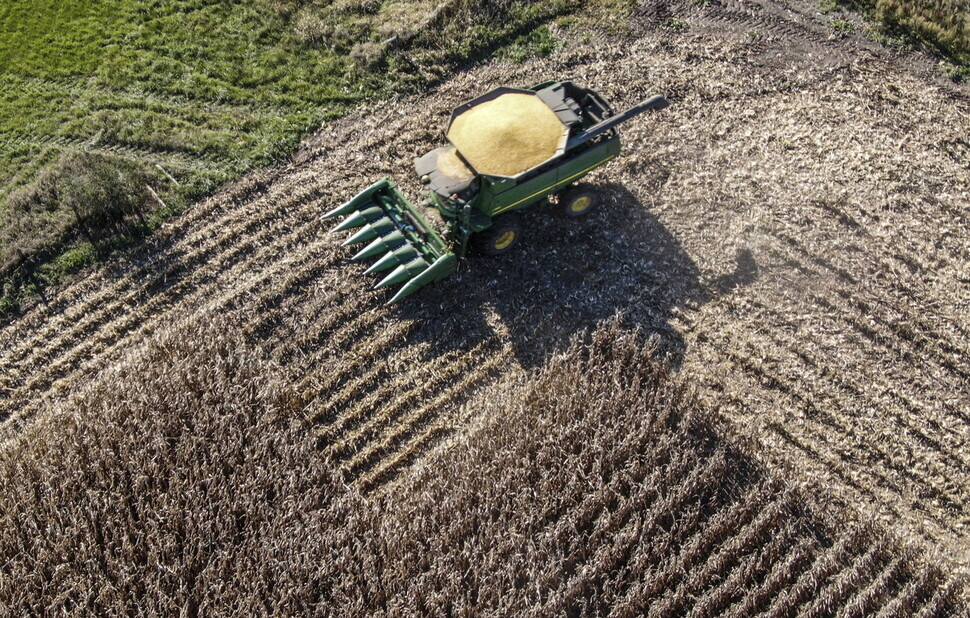hankyoreh
Links to other country sites 다른 나라 사이트 링크
Skyrocketing urea prices give rise to fears of global food shortages

With no remedy in sight to South Korea’s shortage of urea water solution, analysts are predicting a possible blow to global food supplies from the rising price of urea, a compound used in fertilizer.
An examination of data from the global energy, agriculture, and weather data firm DTN on Monday showed the average price of urea to be US$751 per ton for major global fertilizer companies during the last week of October. The number was up 21% from the US$620 recorded in the last week of September.
It’s also more than double the price of US$358 per ton in October 2020 and represents the highest price overall in the nine years since May 2012, when it was recorded at US$770.
Urea is a necessary component of urea water solution, known also as diesel exhaust fluid, which is required in most diesel vehicles. But it is more commonly used in nitrogen fertilizers, which are the most widely used chemical fertilizers.
Urea is typically produced with ammonia extracted from coal and natural gas. With coal and natural gas prices rising, the price of urea has skyrocketed. Another contributing factor is the restrictions imposed by China — one of the world’s largest producers of urea — as it attempts to meet its own demand.
The rise in fertilizer prices isn’t restricted to urea. Prices have also been spiking for potassium and diammonium phosphate (DAP), which are among the three main fertilizer ingredients alongside nitrogen.
According to DTN figures, potassium sold for US$731 per ton during the last week of October — up 12.9% from US$647 a month earlier, and 2.5 times higher than the US$332 average price recorded a year before. The trend resembles the increase in urea prices.
The same can be said of DAP. As of the last week of October, DAP sold for US$812 per ton, which was almost double the US$448 price a year earlier.
The rise in fertilizer prices is expected to lead to a drop in fertilizer supplies. Bloomberg and other news sources have predicted that a global drop in crop yields could occur next year.
In a recent meeting to announce third-quarter performance, the US fertilizer company CF Industries Holdings Inc. said intense global demand for fertilizer would continue at least through 2023, predicting that quantities would not be able to keep pace with demand.
Unless fertilizer can be acquired to make up the difference, the result could be a decline in next year’s global grain harvest, it said.
The fertilizer shortage is already affecting the world in different ways. According to a Bloomberg report, around 30% of coffee farmers in Brazil — the world’s largest coffee producer — have not received the fertilizer they have ordered, while urea imports to Peru have been delayed by up to three months.
This is expected to hurt rice production in Thailand, a major exporter of the grain. The president of the Thai Agriculturist Association called for the government to take action, saying that “a ton of fertilizer is now more expensive than a ton of rice.”
The fertilizer shortage is already being reflected in rising global food prices. On Friday, the Food and Agriculture Organization of the UN (FAO) announced a Food Price Index score of 133.2 points, up by 3% from the month before. The index has been rising for four straight months since July, reaching its highest level in over ten years since July 2011.
By Choi Hyun-june, staff reporter
Please direct questions or comments to [english@hani.co.kr]

Editorial・opinion
![[Guest essay] The real reason Korea’s new right wants to dub Rhee a founding father [Guest essay] The real reason Korea’s new right wants to dub Rhee a founding father](https://flexible.img.hani.co.kr/flexible/normal/500/300/imgdb/original/2024/0423/8317138574257878.jpg) [Guest essay] The real reason Korea’s new right wants to dub Rhee a founding father
[Guest essay] The real reason Korea’s new right wants to dub Rhee a founding father![[Column] ‘Choson’: Is it time we start referring to N. Korea in its own terms? [Column] ‘Choson’: Is it time we start referring to N. Korea in its own terms?](https://flexible.img.hani.co.kr/flexible/normal/500/300/imgdb/original/2024/0423/3617138579390322.jpg) [Column] ‘Choson’: Is it time we start referring to N. Korea in its own terms?
[Column] ‘Choson’: Is it time we start referring to N. Korea in its own terms?- [Editorial] Japan’s rewriting of history with Korea has gone too far
- [Column] The president’s questionable capacity for dialogue
- [Column] Are chaebol firms just pizza pies for families to divvy up as they please?
- [Column] Has Korea, too, crossed the Rubicon on China?
- [Correspondent’s column] In Japan’s alliance with US, echoes of its past alliances with UK
- [Editorial] Does Yoon think the Korean public is wrong?
- [Editorial] As it bolsters its alliance with US, Japan must be accountable for past
- [Guest essay] Amending the Constitution is Yoon’s key to leaving office in public’s good graces
Most viewed articles
- 1[Guest essay] The real reason Korea’s new right wants to dub Rhee a founding father
- 2Terry Anderson, AP reporter who informed world of massacre in Gwangju, dies at 76
- 3Why Korea shouldn’t welcome Japan’s newly beefed up defense cooperation with US
- 4[Column] ‘Choson’: Is it time we start referring to N. Korea in its own terms?
- 5Senior doctors cut hours, prepare to resign as government refuses to scrap medical reform plan
- 6Opposition calls Yoon’s chief of staff appointment a ‘slap in the face’
- 7[Column] The clock is ticking for Korea’s first lady
- 8New AI-based translation tools make their way into everyday life in Korea
- 9[Editorial] Japan’s rewriting of history with Korea has gone too far
- 10[Column] Are chaebol firms just pizza pies for families to divvy up as they please?